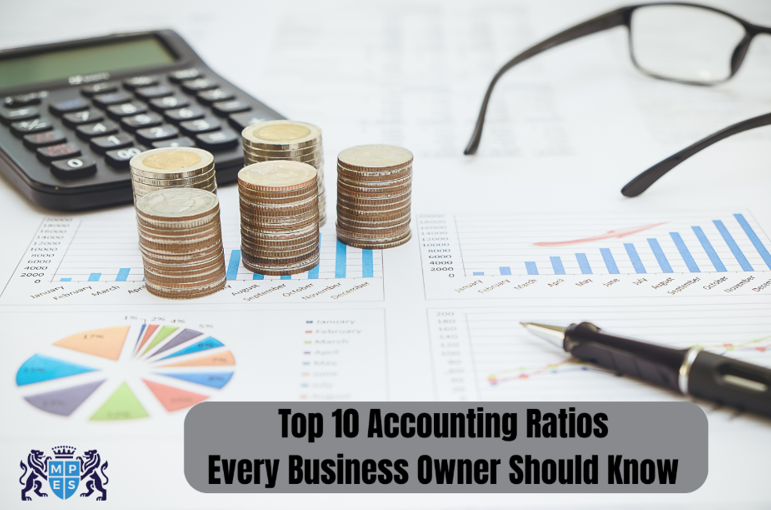If you are preparing for the CIMA Certificate in Business Accounting, you already think like a decision maker. The best tools are simple and quick. One of the most useful is Accounting Ratios. These numbers turn long reports into clear signals. They help you judge cash, profit, and risk with confidence.
In this blog, we explore ten vital ratios for owners. Each one is explained in plain steps, and with a short tip you can try today.
Table of Contents
- Current Ratio for Calm Cash Flow
- Quick Ratio for Fast Liquidity Checks
- Gross Profit Margin and Pricing Power
- Net Profit Margin for Overall Performance
- Return on Equity for Owner Value
- Return on Assets for Smart Use of Resources
- Debt to Equity Ratio for Sensible Leverage
- Interest Coverage Ratio for Lender Confidence
- Inventory Turnover for Healthy Stock
- Asset Turnover for Sales Momentum
- Conclusion
1. Current Ratio for Calm Cash Flow
This liquidity ratio shows whether you can meet near-term bills. It measures current assets in relation to current liabilities. Aim for a figure above one. That tells you working capital is safe. Track it monthly. If it dips, tighten credit terms or slow non-essential buying. Use it as a quick financial analysis check.
2. Quick Ratio for Fast Liquidity Checks
The quick ratio removes stock from current assets. It tests your most liquid assets against short-term debts. It is helpful if the stock moves slowly. A steady result near one brings comfort. If it slips, improve collections and review cash buffers. Add this to your weekly ratio analysis.
3. Gross Profit Margin and Pricing Power
This profitability ratio shows the money left after the cost of goods sold. It is gross profit divided by revenue. A higher margin signals strong pricing and cost control. Watch for small declines across months. That can point to discounts or rising input costs. Use the insight to reset price or renegotiate supply.
4. Net Profit Margin for Overall Performance
The net profit margin is the final truth on earning power. It is profit after all costs and tax divided by revenue. Compare it with your sector. If it is below peers, examine overheads and product mix. Small gains here lift cash and value. It is a core financial analysis indicator for owners.
5. Return on Equity for Owner Value
Return on equity shows how well the business uses shareholder funds. It is profit after tax divided by average equity. A rising figure means a stronger value for owners. If it falls, review pricing, cost base, and capital needs. This metric supports better dividend plans and long-term growth choices.
6. Return on Assets for Smart Use of Resources
Return on assets measures how profit relates to the asset base. It is profit after tax divided by average total assets. Asset-heavy firms rely on it. If the number is low, look at capacity use and asset sales. Link it with efficiency ratio targets to push more revenue from the same resources.
7. Debt to Equity Ratio for Sensible Leverage
The debt-to-equity ratio compares borrowed funds with owner funds. A moderate level can speed growth. A high level raises risk when sales slow. Track the trend across quarters. Pair it with plans for repayments and cash reserves. This classic leverage ratio keeps balance sheet risk in view.
8. Interest Coverage Ratio for Lender Confidence
This ratio tests how easily you can pay interest. Use earnings before interest and tax divided by interest expense. A higher figure gives lenders comfort. If it weakens, delay new loans and improve operating profit. Better coverage also supports stronger terms in the next funding round.
9. Inventory Turnover for Healthy Stock
Inventory turnover shows how often you sell and replace stock. It is the cost of goods sold divided by average inventory. Higher turns free cash and reduces storage costs. If turns are slow, cut deadlines and improve demand forecasts. Pair it with cash flow plans so buying matches sales pace.
10. Asset Turnover for Sales Momentum
Asset turnover highlights how well assets produce revenue. It is sales divided by average total assets. Rising turnover often signals sharper sales execution and better use of kit. If it drifts down, review store layout, fleet use, or site uptime. Combine it with efficiency ratio targets for teams.
Conclusion
These ten Accounting Ratios give you a compact view of health and risk. They support better pricing, cleaner cost control, and stronger cash planning. Start with two, add more, and review them on a steady cycle. For guided practice with real statements and clear steps, explore MPES Learning. Build skill through short lessons, timely examples, and friendly support that turns insight into action.
